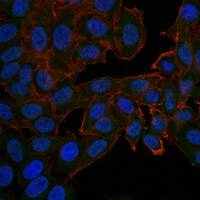05-184-AF488 Sigma-AldrichAnti-Src Antibody, clone GD11, Alexa Fluor® 488 conjugate
Anti-Src Antibody, clone GD11, Alexa Fluor® 488 conjugate is an antibody against Src for use in Immunocytochemistry.
More>> Anti-Src Antibody, clone GD11, Alexa Fluor® 488 conjugate is an antibody against Src for use in Immunocytochemistry. Less<<Prodotti consigliati
Panoramica
| Replacement Information |
|---|
Tabella delle specifiche principali
| Species Reactivity | Key Applications | Host | Format | Antibody Type |
|---|---|---|---|---|
| Av, R, M, H, Mi | ICC | M | AlexaFluor®488 | Monoclonal Antibody |
| References |
|---|
| Product Information | |
|---|---|
| Format | AlexaFluor®488 |
| Presentation | Purified mouse monoclonal IgG1 antibody conjugate in PBS with 15 mg/mL BSA and 0.1 % sodium azide. |
| Quality Level | MQ100 |
| Physicochemical Information |
|---|
| Dimensions |
|---|
| Materials Information |
|---|
| Toxicological Information |
|---|
| Safety Information according to GHS |
|---|
| Safety Information |
|---|
| Storage and Shipping Information | |
|---|---|
| Storage Conditions | Stable for 1 year at 2-8°C from date of receipt. |
| Packaging Information | |
|---|---|
| Material Size | 100 µL |
| Transport Information |
|---|
| Supplemental Information |
|---|
| Specifications |
|---|
| Global Trade Item Number | |
|---|---|
| Numero di catalogo | GTIN |
| 05-184-AF488 | 04055977330564 |
Documentation
Anti-Src Antibody, clone GD11, Alexa Fluor® 488 conjugate MSDS
| Titolo |
|---|
Anti-Src Antibody, clone GD11, Alexa Fluor® 488 conjugate Certificati d'Analisi
| Titolo | Numero di lotto |
|---|---|
| Anti-Src, clone GD11, Alexa Fluor® -Q2660280 | Q2660280 |
| Anti-Src, clone GD11, Alexa Fluor® 488 conjugate - 3273580 | 3273580 |








